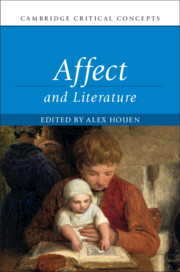Book contents
- Affect and Literature
- Cambridge Critical Concepts
- Affect and Literature
- Copyright page
- Contents
- Notes on Contributors
- Introduction
- I Origins
- Chapter 1 Poetic Fear-Related Affects and Society in Greco-Roman Antiquity
- Chapter 2 Secondary Affect in Lessing, Mendelssohn, and Nicolai
- Chapter 3 Affect and Life in Spinoza, Nietzsche, and Bergson
- Chapter 4 Feelings under the Microscope: New Critical Affect
- Chapter 5 ‘We Manufacture Fun’: Capital and the Production of Affect
- Chapter 6 Jacques Lacan’s Evanescent Affects
- Chapter 7 The Durability of Affect and the Ageing of Gay Male Queer Theory
- Chapter 8 Affect, Meaning, Becoming, and Power: Massumi, Spinoza, Deleuze, and Neuroscience
- Chapter 9 Translating Postcolonial Affect
- Chapter 10 Making Sorrow Sweet: Emotion and Empathy in the Experience of Fiction
- II Developments
- III Applications
- Index
Chapter 6 - Jacques Lacan’s Evanescent Affects
from I - Origins
Published online by Cambridge University Press: 16 January 2020
- Affect and Literature
- Cambridge Critical Concepts
- Affect and Literature
- Copyright page
- Contents
- Notes on Contributors
- Introduction
- I Origins
- Chapter 1 Poetic Fear-Related Affects and Society in Greco-Roman Antiquity
- Chapter 2 Secondary Affect in Lessing, Mendelssohn, and Nicolai
- Chapter 3 Affect and Life in Spinoza, Nietzsche, and Bergson
- Chapter 4 Feelings under the Microscope: New Critical Affect
- Chapter 5 ‘We Manufacture Fun’: Capital and the Production of Affect
- Chapter 6 Jacques Lacan’s Evanescent Affects
- Chapter 7 The Durability of Affect and the Ageing of Gay Male Queer Theory
- Chapter 8 Affect, Meaning, Becoming, and Power: Massumi, Spinoza, Deleuze, and Neuroscience
- Chapter 9 Translating Postcolonial Affect
- Chapter 10 Making Sorrow Sweet: Emotion and Empathy in the Experience of Fiction
- II Developments
- III Applications
- Index
Summary
There is an urgent need to elaborate a theory of affects for Lacanian psychoanalysis. This is Colette Soler’s intention in her book Lacanian Affects: The Function of Affect in Lacan’s Work (2015). Soler announces that she will provide a systematic overview of Lacan’s copious yet misunderstood theses on affects. Indeed, her book engages with affects like “anguish” (Fink has decided to choose this term to render the French word of angoisse, instead of the more common “anxiety”) but also sadness, joy, guilt, boredom, moroseness, anger, shame, love, hatred, enthusiasm, and so on. Soler rightly points out Lacan’s Freudian point of departure and highlights his distinctive contribution, even though she acknowledges that his concept of affect was fraught with tensions, false starts, or even contradictions. Lacan, as usual, offers brilliant insights couched in impenetrable and punning prose. When closing Soler’s book, though, one cannot help registering a certain degree of frustration: the original promise of presenting a clear and systematic Lacanian theory of affects has not been fulfilled; too often, the book remains mimetic in tone and style and not explanatory enough.
- Type
- Chapter
- Information
- Affect and Literature , pp. 116 - 132Publisher: Cambridge University PressPrint publication year: 2020

